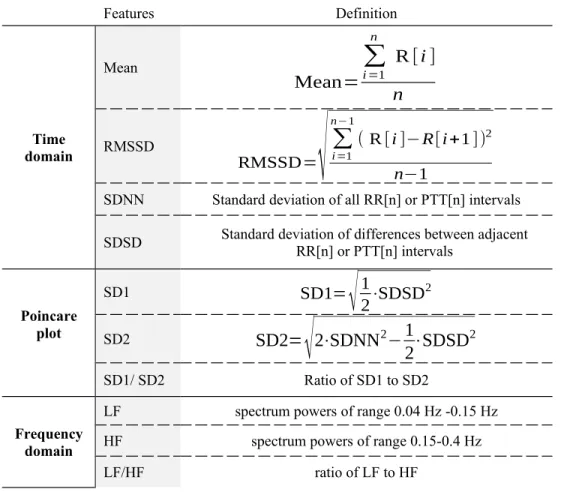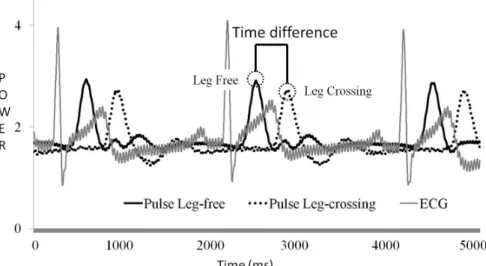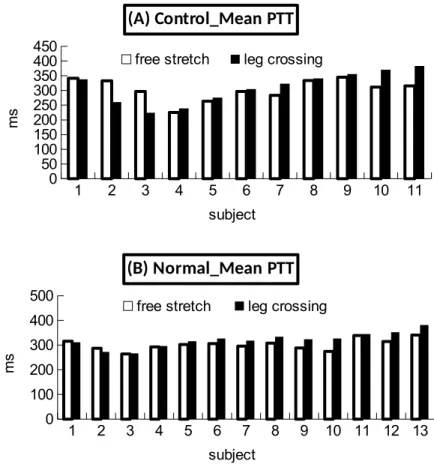Heart Rate Variability and Pulse Transit Time
Performance of Leg Crossing on Meditation
Practitioner
Sih-Huei Chen
1, Congo Tak-Shing Ching
2$, Kang-Ming Chang
3,4*1Department of Computer Science and Information Engineering, Asia University, Taichung, Taiwan 2Department of Electrical Engineering, National Chi Nan University, Nantou, Taiwan 3Department of Photonics and Communication Engineering, Asia University, Taichung, Taiwan
4Graduate Institute of Clinical Medical Science, China Medical University, Taichung, Taiwan $The same contribution of the first author
*Correspondence to: Kang-Ming Chang, Tel: +886-4-23323456-20003, Fax: +886-4-23316699, E-mail: changkm@asia.edu.tw
Meditation is the traditional eastern method to improve health. Leg crossing is the main component on meditation to enhance the inner chi circulation. In this study, leg crossing effects was investigated with physiological parameters for meditation group. Five minute heart rate variability (HRV) and pulse transit time (PTT) was measured as feature for leg crossing. College students were recruited as subjects. There were 11 subjects as control group and 13 subjects with more than two years meditation practice experience as experimental group. Subjects were asked to sit with both legs stretched horizontally, and then in two half-lotus postures for five minutes, respectively. PTT was estimated from the ECG R peak to a characteristic point on the peripheral pulse by photoplethysmography (PPG). Physiological performances between free stretch and leg crossing posture were investigated. As concerned about the difference between free stretch and leg crossing posture, results indicated that there was significant HRV power increase but no PTT difference for meditation group, while there was less HRV variation but significant PTT increase for control group. PTT was proposed to be a good feature to measure meditation practice performance with the leg crossing practice.
Key words: Heart rate variability, leg crossing, meditation, pulse transit time
INTRODUCTION
Ancient eastern exercise, such as Tai Chi, Yoga and Meditation played important roles on health and life. These exercises strengthened body structures with all aspects. Recent academic research on Tai Chi exercise thought it as a popular form of exercise in China among older adults. Tai Chi was not only though of exercise to improved balance, muscular strength and endurance, and flexibility in older adults [1]. Another important eastern exercise was meditation. Similar to Tai Chi, meditation was also thought to increase the flow of inner chi with more subtle approach [2]. There were many researches devoted on meditation study. After the pilot study by Wallace[3], it was widely investigated. Recently, Tang et. al [4] measured the physiological and brain changes at rest before, during, and after 5 days of body-mind training and relaxation training. Their results showed significantly improved physiological reactions in heart rate, respiratory amplitude and rate, and skin conductance response of body-mind training group than the relaxation control.
The autonomous nervous function of meditation practitioner was also widely investigated, and it was mainly based on the heart rate variability (HRV) analysis derived from ECG signal. HRV is the variation of consecutive heartbeats. HRV is thought to reflect the state of autonomous nervous system, which is responsible for regulating cardiac activities. HRV power spectrum is divided into three ranges: very low-frequency range (VLF, < 0.04 Hz), low low-frequency range (LF, 0.04-0.15 Hz) and high low-frequency range (HF,
They emphasized on inward attention property of meditation, and found that meditation may decrease LF/HF ratio and LF norm as well as the increase of HF norm, which suggested the benefit of a sympathovagal balance toward parasympathetic activity.
Leg crossing is the fundamental physical posture for meditation, and it may be help to regulate cardiovascular function [7]. Leg crossing posture was believed increasing the circulation of inner chi for meditation and Yoga practitioner. Previous study of leg crossing showed that mean blood pressure, stroke volume and cardiac output were significantly higher with legs crossed than in the uncrossed position; while the heart rate was also significantly lower [8]. HRV analysis showed that both LF and HF powers increased when leg crossed compared with free stretch posture, and there was significant difference of HF than LF on leg crossing effect [9]. Although leg crossing was such an important issue for meditation, there was few discussion of leg crossing posture effect for meditation. In this study, we will investigate the physiological performance of leg crossing.
In additional to traditional ECG measurement, a novel measure based on limb pulse signal, pulse transit time (PTT) was also investigated. PTT was measured from the ECG R wave to a characteristic point on the peripheral pulse by photoplethysmography (PPG). PTT was an attractive tool recently used for biomedical investigation, and it may be influenced with heart rate, blood pressure changes and the compliance of the arteries. Previous results showed that the variation of PTT was more sensitive to leg crossing posture than corresponding HRV parameters, especially on average PTT, HF and some other HRV derived parameters. Those parameters were increased with leg crossing posture [9]. Recent application of PTT in posture variation studies focused on differences of PTT on all four limbs during two positional changes (lowering and raising of a limb) [10-11] .
Considering the case of leg crossing, there was extra hindrance for pulse travelling to the end of limb, which increased PPT, and even depresses pulse pattern. Therefore PTT was sensitive to the change of leg posture, and it became potential parameters to describe meditation effects. The aim of this study was to investigate leg crossing effect with meditation group and control group by HRV and PTT features.
METHODS Subjects
Two groups were involved in this study, one was control group (11 volunteers) and the other was meditation group (13 volunteers, average two year meditation practicing experience). Both groups were mainly college students. Single ECG and four limb pulse signals were recorded using the IWORX® system (sampling frequency was 2000 Hz) for each participant. Postures with leg crossing and leg stretching were used to investigate the posture variation effects. Subjects were asked to sit with both legs stretched horizontally for five minutes, and then in a half-lotus posture with the left leg on top of the right for another five minutes, followed with the right leg on top of the left leg for the other five minutes. The recorded ECG and pulse signals were illustrated in Figure 1.
ECG Signal Processing
The ECG R peak detection was manly based on modified Tompkin’s algorithm [12] and the algorithm’s details were described in previous study [9]. Five-minute RR intervals were used to estimate traditional HRV parameters, such as mean RR, RMSSD, SDNN and SDSD. The frequency domain features, LF, HF, LF/HF and SD1, SD2, and Poincare plot parameters were also included. The definition of HRV parameters used in the following study was listed in Table 1.
Figure 1. Illustration of Recorded ECG and Pulse Signals. PTT was defined as the duration between ECG R peak and adjacent maximum pulse wave peak. Unit of x-axis is mini-second.
Table 1. The Definition of HRV Parameters Used in this Study.
Features Definition Time domain Mean
Mean=
∑
i =1 nR [ i ]
n
RMSSD RMSSD=√
∑
i=1 n−1 ( R [i ]−R[i+1 ])2 n−1SDNN Standard deviation of all RR[n] or PTT[n] intervals SDSD Standard deviation of differences between adjacentRR[n] or PTT[n] intervals
Poincare plot SD1
SD1=
√
1
2
⋅
SDSD
2 SD2SD2=
√
2⋅SDNN
2−
1
2
⋅SDSD
2 SD1/ SD2 Ratio of SD1 to SD2 Frequency domainLF spectrum powers of range 0.04 Hz -0.15 Hz HF spectrum powers of range 0.15-0.4 Hz
Pulse Signal Processing
The first pulse peak position was extracted as features. PTT was estimated as sequences of time difference between first pulse peak position and ECG R-wave peak position, as illustrated in Figure 1. The PTT variability was estimated similar to the HRV definition, taking place of traditional RR interval by PTT sequence.
Statistical Analysis
Student’s paired t-tests were used to compare differences between the two postures based on HRV and PTT parameters. Statistics is estimated by EXCEL was used to examine the interaction of two posture and two subject groups. Two-way ANOVA analysis was used to examine the interaction of two posture and two subject groups, and was executed by SPSS v12 software. Alpha value is 0.05 in this study.
Results
Detail HRV parameters of meditation and control group on both leg postures and t-test results were listed in Table 2. According to Table 2, Time domain and frequency domain features all had increasing average and increasing standard deviation value due to leg crossing for meditation group. It was also seen that meditation group had higher HRV change than control group due to leg crossing. The most significant change was shown on SDNN, SDSD, RMSSD and SD1 (p<0.05) for meditation group. On the other hand, there was little change for control group with leg crossing. Two-way ANOVA analysis of HRV for both groups and both leg postures also indicated that there was no significant interaction between subject group and leg crossing posture.
Table 2. HRV Value on Both Leg Postures. HRV data was presented by mean and standard deviation (in parenthesis). * p<0.05
Group Meditation Group Control Group Free Crossing Posture Free Crossing Free Crossing Meditationvs. Control vs. ControlMeditation Statistics mean(std) P alue mean(std) P value P value
Mean RR (ms) (80.0)779.5 (71.3)789.1 0.25 (67.4)760 (76.8)787.9 0.012 * 0.85 0.45 SDNN (ms) (17.8)54.6 (20.5)62.3 0.019 * (12.9)50.8 (13.7)49.2 0.52 0.03* 0.44 SDSD (ms) (30.5)43.4 (34.0)51.1 0.039 * (16.7)39.6 (15.0)38.1 0.73 0.13 0.67 RMSSD (ms) (30.5)43.4 (34.0)51.0 0.039 * (16.7)39.6 (15.0)38.1 0.73 0.13 0.67 SD1 30.7 (21.6) (24.1)36.2 0.039 * (11.8)28.0 (10.6)27 0.73 0.13 0.67 SD2 69.6 (18.6) (24.1)78.5 0.07 (17.4)65.4 (17.8)63.8 0.56 0.06 0.44 SD1/SD2 0.43 (0.21) (0.26)0.47 0.54 (0.19)0.44 (0.13)0.43 0.7 0.53 0.79 LF (*E9 ms2) (1.98)2.43 (4.07)3.54 0.2 (1.33)1.82 (1.03)1.73 0.84 0.09 0.25 HF (*E9 ms2) (1.16)1.23 (2.34)1.99 0.12 (1.13)1.32 (1.13)1.51 0.66 0.39 0.76
LF/HF 4.02
(3.90) (6.31)4.38 0.78 (1.98)1.98 (3.05)2.03 0.96 0.16 0.04*
Figure 2. Typical ECG and Two Leg’s Pulse Signal. PTT of left leg was always shorter than that of right leg. Unit of x-axis was mini-second.
Figure 3. Typical ECG and Left Leg’s Pulse Signal with Free Stretch (solid line) and with Leg Crossing (dotted line) for Control Subject. It was seen that PTT with free stretch was shorter than PTT with leg crossing for the same leg. Unit of x-axis was mini -second.
Typical ECG and two leg’s pulse signal was shown in Figure 2. It was obviously that the PTT of left leg was shorter than that of right leg. Pulse wave velocity measured at left leg and right leg was assumed to be similar. Difference of pulse wave traveling distance between both legs was the major difference of PTT on both legs. PTT difference between free stretch and half-lotus leg crossing was listed in Table 3 and illustrated in Figure 3. It was obviously that PTT of leg crossing was longer than PTT of free stretch. There was significant PTT increasing when leg crossing for control group, but there was no any statistically difference of PTT for meditation group. The PTT distribution of meditation group and control group were further investigated for each subjects and demonstrated in Figure 4. It was obvious result with PTT
showing opposite result for meditation group revealed in Figure 4(B). Further investigation of two-way ANOVA analysis of PTT indicated that there was also no significant interaction between subject group and leg crossing posture on PTT derived features.
1 2 3 4 5 6 7 8 9 10 11 0 50 100 150 200 250 300 350 400 450
(A) Control_Mean PTT
free stretch leg crossing
subject m s 1 2 3 4 5 6 7 8 9 10 11 12 13 0 100 200 300 400 500
(B) Normal_Mean PTT
free stretch leg crossing
subject
m
s
Figure 4. Average Left Leg’s PTT Distribution of Free Stretch and with Leg Crossing Postures for all control group subjects (4A) and meditation group (4B) subjects. Unit of x-axis is subject number. Unit of y-axis was mini-second.
DISCUSSION
This study focused on physiological variation due to leg crossing. Novel physiological parameter PTT was introduced and compared with HRV of leg crossing variation. There was significant difference between free stretch and leg crossing posture, especially on PTT. The main difference between HRV and PTT was that PTT included the information of blood pressure circulation while HRV only contained the cardio activity information. When leg crossed, there was a hindrance for pulse wave to travel from heart to the peripheral point, and more travelling time was required, therefore increased pulse transit time, also accompanied with higher PTT variability.
From the result of table 2, meditation group has statistically HRV parameter increasing performance than control group on leg crossing, especially on SDNN, SDSD, RMSSD and SD1. Increasing of most HRV parameters means that leg crossing increased the overall autonomic nervous activity for meditation practitioners, but there was little effect for control group.
Table 3. PTT Value on Both Leg Postures. PTT data was presented by mean and standard deviation (in parenthesis).* p<0.05
Group Meditation Group Control Group Free Crossing Posture Free Crossing Free Crossing Meditation Control vs
vs Control Meditation Statistics mean(std) P value mean(std) P value P value
Mean PTT (ms) (42.45)287.28 (54.89)305.81 0.92 (24.21)303.06 (31.77)318.27 0.13 0.67 0.01* SDNN (ms) (22.36)317.49 (27.66)339.64 0.33 (18.07)309.8 (24.88)344.53 0.44 0.19 0.44 SDSD (ms) (5.57)6.81 (6.82)9.9 0.3 (4.02)7.55 (31.49)18.3 0.65 0.25 0.56 RMSSD (ms) 6.97 (5.53) 11.5 (8.26) 0.3 7.57 (5.46) 10.4 (11.17) 0.04* 0.25 0.56 SD1 7.36 (7.35) 8.12 (9.93) 0.3 9.28 (5.8) 12.74 (9.01) 0.65 0.25 0.56 SD2 8.12 (7.3) 12.66(8.3) 0.27 (8.77)8.88 (15.97)11.7 0.35 0.16 0.4 SD1/SD2 7.57 (7.13) (9.92)12.05 0.59 (5.8)9.27 12.73(9.0) 0.88 0.75 0.91
From the result of table 3, there was little PTT difference on leg crossing for meditation, but there was significant PTT increase for control group due to leg crossing. PTT was expected increasing due to leg crossing that was widely observed for control group. An interesting hypothesis was therefore proposed according to above discussion: Leg crossing can improve the chi circulation, especially for experienced practitioner. Short-term leg crossing for meditation group can enhance the autonomic nervous system, both on sympathetic and parasympathetic nervous system. Crossing between legs provided an unstable hindrance on pulse wave propagation that was shown on the higher PTT variability, as shown in table 3. Another interesting hypothesis is that meditation practice may decrease PTT when leg crossing. That is also due to the increase of chi circulation for experienced meditation practitioners. Therefore, PTT may be a good candidate feature to show the degree of inner chi circulation after meditation practice.
Most people feel a painful experience when they practiced leg crossing first time. Similar with other exercise, constant practicing made them accustomed with leg crossing, and also accompanied with a smoother and faster circulation of chi, and increasing of autonomic nervous system, mainly on parasympathetic nervous activity. Leg crossing practice therefore made people feel more comfortable. In the future, long term leg crossing will be investigated and more HRV and PTT information will be revealed than this five minute leg crossing experiments. More experienced meditation practitioners will also be invited to join this study to test the interesting hypothesis. And further physiological meaning of PTT variability will be investigated.
Leg crossing is a tradition Eastern health promotion activity. Experienced leg crossing practitioners such a meditation group revealed the benefit of leg crossing with an improvement of inner chi circulation. Leg crossing will increase PTT for control group. PTT of meditation practitioner may decrease due to smoother circulation of “chi”, and PTT therefore as candidate feature to measure meditation practice performance.
ACKNOWLEDEGMENT
Supported by the National Science Council of Taiwan (grant number NSC 100-2221-E-468-004-) and Asia University (grant number 100-A-13)
[1] Taylor-Piliae RE, Haskell WL, Stotts NA,Froelicher ES (2006). Improvement in balance, strength, and flexibility after 12 weeks of Tai chi exercise in ethnic Chinese adults with cardiovascular disease risk factors. Altern Ther Health Med. 12(2): 50-58.
[2] Lo PC, Huang ML,Chang KM (2003). EEG alpha blocking correlated with perception of inner light during zen meditation. Am J Chin Med. 31(4): 629-642.
[3] Wallace RK (1970). Physiological effects of transcendental meditation. Science. 167(3926): 1751-1754.
[4] Tang YY, Ma Y, Fan Y, Feng H, Wang J, Feng S, Lu Q, Hu B, Lin Y, Li J, Zhang Y, Wang Y, Zhou L,Fan M (2009). Central and autonomic nervous system interaction is altered by short-term meditation. Proc Natl Acad Sci U S A. 106(22): 8865-8870.
[5] Rajendra Acharya U, Paul Joseph K, Kannathal N, Lim CM,Suri JS (2006). Heart rate variability: a review. Med Biol Eng Comput. 44(12): 1031-1051.
[6] Wu SD,Lo PC (2008). Inward-attention meditation increases parasympathetic activity: a study based on heart rate variability. Biomed Res. 29(5): 245-250.
[7] Ko JH, Kuo TB,Lee GS (2008). Effect of postural change on nasal airway and autonomic nervous system established by rhinomanometry and heart rate variability analysis. Am J Rhinol. 22(2): 159-165.
[8] van Groningen LF, Adiyaman A, Elving L, Thien T, Lenders JW,Deinum J (2008). Which physiological mechanism is responsible for the increase in blood pressure during leg crossing? J Hypertens. 26(3): 433-437.
[9] Chang KM,Chang KM (2008). Leg Crossing Posture on Pulse Transit Time and Heart Rate Variability. J Med Biol Eng. 28(2): 5.
[10] Foo JY, Wilson SJ, Williams GR, Harris MA,Cooper DM (2005). Pulse transit time changes observed with different limb positions. Physiol Meas. 26(6): 1093-1102.
[11] Foo JY (2007). A computational approach to predict pulse transit time variations during postural change. Cardiovasc Eng. 7(3): 121-126.
[12] Hamilton PS,Tompkins WJ (1986). Quantitative investigation of QRS detection rules using the MIT/BIH arrhythmia database. IEEE Trans Biomed Eng. 33(12): 1157-1165.



